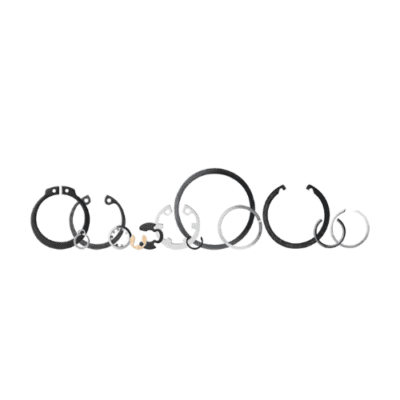Using Retaining Rings Properly

Retaining rings have a variety of forms, each designed for specific applications.
Retaining rings are mechanical fasteners that form fixed shoulders to secure components in place. The rings deform during installation or removal, yet spring back to their original shape. Because of the spring characteristics, retaining rings can be used in a wide variety of applications.
Advantages
• Cost Saving – retaining rings are used in place of traditional fasteners and often replace two or more parts. They use less raw material and their installation doesn’t require threads, eliminating complex machining.
• Compact Assembly – comparable to other fastening processes assemblies with retaining rings are more compact and can be put together rapidly.
• Easy to install – workers don’t need elaborate training sessions to learn how to install components held by retaining rings. They are lightweight, easy to install and work for most fastening requirements.
There are several factors to consider ensuring that a ring functions properly and will be problem-free once the design reaches prodduction.
Step 1 – Determine the type of ring to use.
Retaining rings are available in a variety of styles that are installed either axially or radially in a housing or on a shaft. Internal rings, also called housing rings, are assembled into grooves or recesses in bores and housings, whilst external types or shaft rings are installed on the outside diameter of pins, studs, shafts, and similar parts.
Other applications use the retaining ring to take up end-play and to act as a spring or as a preload on parts to reduce chatter or vibration. These rings are either bowed or beveled. The bowed rings are curved and exert a preload on the assembly when installed in the groove, the beveled rings functions as a wedge. These rings look exactly like their housing and shaft counterparts, only they feature a 15° beveled or angled edge. This angle lets the ring wedge itself between the groove and the retained part until it can go no further, effectively locking everything in place.
Another type of retaining ring is self-locking. This retaining ring works well in applications that require very little thrust to retain the assembly. Self-locking rings don’t need a groove and are ideal for shaft or housing diameters of 1 in. or less.
Step 2 – deciding whether to use an axially or radially assembled ring
An axial retaining ring is installed into a groove in a shaft or bore along an axis center point and have lugs and lug holes that are used for installation. Once installed, they contact virtually the entire groove. They transmit loads into the groove wall around most of the groove circumference, which lets them withstand significant thrust loadings.
A radially assembled ring is installed along the radius of a circle. The rings don’t have lugs or lug holes and don’t extend as far around the circumference of the groove as their axial counterpart. Because of the gap portion, they accept less thrust loads to the groove wall.
Step 3 – Choosing the correct size of ring
Ring size is determined by the diameter of the housing or shaft. Retaining rings are made to standards such as inch, DIN, ANSI METRIC, and JIS.
Step 4 – Selecting the material and finish for your retaining ring
Retaining rings are generally available in three types of material. One is carbon spring steel (SAE 1060-1090), which is the most widely used material. It has high strength, good ductility, and an excellent surface for plating to ensure corrosion resistance. The second most common material is stainless steel (PH 15-7Mo). This is strong, corrosion-resistant steel that’s capable of preventing atmospheric oxidation at temperatures up to 900°F. The third material is beryllium copper, which is nonmagnetic, conducts electricity, and is highly corrosion resistant to sea air and saltwater.
Not only is the material important, but the finish on a retaining ring is another consideration to prevent corrosion. Standard is a phosphate finish because it offers shelf-life protection against rust. Another finish is mechanical zinc plating. It resists corrosion up to 96 hr in salt spray, and is particularly effective for applications exposed to corrosive environments. In addition, zinc dichromate lacquer offers corrosion protection of up to 240 hr of salt spray. In some applications, it is a low-cost substitute for costly noncorrosive materials such as stainless steel.
Learn more about the materials and finishes Rotor Clip offers for retaining rings.
Step 5 – Choosing installation tools
Once a retaining ring is selected, the next step is to choose installation tools. Retaining rings can be installed by a variety of manual and automatic tools, including pliers and pneumatic tools for axial retaining rings, and applicators and dispensers for radial retaining rings. Avoid using fingers, hammers, and makeshift devices as tools because they can cause injury as well as damage components. For high-volume installation, automatic assembly equipment is often used.
Step 6 – Select packaging
The final consideration is packaging. Retaining rings are supplied in two ways. One is bulk-packaging in varying-size boxes or bags, depending upon the part size and will work best if the part will be installed with a manual installation tool. The other packaging method stacks the rings onto one another by using automated equipment, and then they are taped in that position. The resulting cartridges can be fed into automated assembly equipment for easy more efficient ring installation.
More than Parts. A True Partnership.
Our passion is creating the best rings, springs, and clamps. Our mission is to make your work a success. We are here for you.
